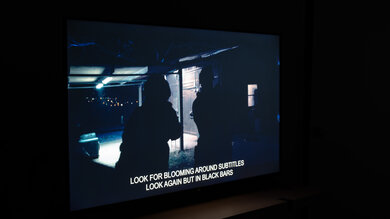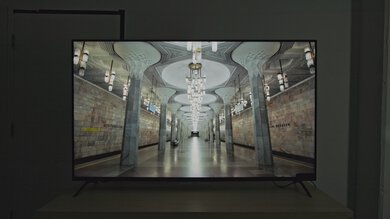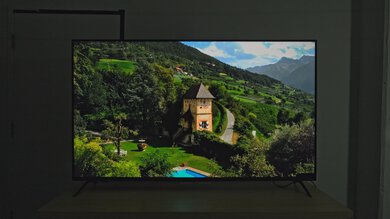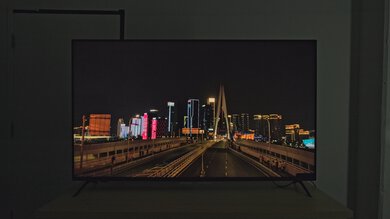The Insignia F50 is an entry-level 4k TV with a quantum dot panel designed to deliver a wider range of colors than traditional LED-backlit TVs. It's a very basic TV released in 2022, and it sits above the Insignia F30 Series 2022. It runs the latest version of Amazon's Fire TV smart interface, with a great selection of streaming apps and an easy-to-use layout. The quantum dot panel delivers an excellent wide color gamut, but sadly, it can't display colors accurately, as saturated colors are terribly oversaturated. The VA panel delivers excellent contrast and good black uniformity, making it a good choice for a dark room, but like most budget TVs, it lacks a local dimming feature to improve contrast. It has decent peak brightness in SDR and decent reflection handling, so it's also a good choice for a moderately-lit room, but it can't overcome bright glare. It also has narrow viewing angles, so it's not a good choice for a wide seating arrangement, as the image degrades when you move off-center.
Our Verdict
The Insignia F50 QLED is an alright TV overall. It's good for watching movies or TV shows in a dark room, as it has excellent contrast and good black uniformity, but it lacks a local dimming feature to improve contrast. It delivers a decent gaming experience with low input lag and a good response time, but it lacks advanced gaming features like variable refresh rate support. It supports HDR and can display a wide color gamut, but it's not bright enough for small highlights to pop, so HDR adds very little overall. It's not suitable for desktop PC use, as it can't display chroma 4:4:4 signals properly, so text looks blurry.
-
Excellent contrast.
-
Great selection of apps.
-
Decent reflection handling.
-
Colors are oversaturated in SDR.
-
Image degrades at an angle.
The Insignia F50 is decent for watching TV shows in a bright room. It has decent peak brightness and reflection handling, so glare isn't an issue in moderately-lit rooms, but it can't overcome glare if you have a lot of windows and no curtains. It has a great selection of streaming apps, so you're sure to find your favorite content, but sadly, it doesn't upscale DVDs properly. Unfortunately, it has a narrow viewing angle, so it's not a good choice for a wide seating arrangement or if you like to move around with the TV on, as the image degrades rapidly as you move off-center.
-
Excellent contrast.
-
Great selection of apps.
-
Decent reflection handling.
-
Colors are oversaturated in SDR.
-
Image degrades at an angle.
The Insignia F50 Series is a decent TV for watching sports in a bright room. Glare isn't an issue in moderately-lit rooms, as it has decent SDR brightness and reflection handling. It has good gray uniformity, but there's some noticeable dirty screen effect when watching sports. Sadly, it has a narrow viewing angle, so it's not ideal for a wide seating arrangement, as the image degrades rapidly as you move off-center.
-
Excellent contrast.
-
Great selection of apps.
-
Decent reflection handling.
-
Colors are oversaturated in SDR.
-
Image degrades at an angle.
The Insignia F50 Series is satisfactory for playing video games. It has outstanding low input lag for a responsive gaming experience and a good response time, but there's still some noticeable blur behind fast-moving objects. It also has excellent contrast and good uniformity, so it's a good choice for gaming in the dark, but it lacks a local dimming feature to improve contrast. Unfortunately, it's limited to a 60Hz refresh rate, and it doesn't support any advanced gaming features like variable refresh rates or HDMI 2.1 bandwidth.
-
Excellent contrast.
-
Excellent low input lag.
-
Good black uniformity.
-
Decent reflection handling.
-
Colors are oversaturated in SDR.
-
No local dimming.
-
No advanced gaming features.
The Insignia F50 QLED is mediocre for watching HDR movies in a dark room. It has excellent contrast and good black uniformity, so blacks are deep and uniform, but it lacks a local dimming feature to improve contrast. It's not very bright in HDR, though, so small highlights don't stand out at all. On the other hand, it has an excellent SDR color gamut, with nearly complete coverage of the DCI-P3 color space used by most current HDR content, so HDR content looks lifelike.
-
Excellent contrast.
-
Great selection of apps.
-
Excellent wide color gamut.
-
Good black uniformity.
-
No local dimming.
-
Can't remove judder from any source.
-
Low peak brightness in HDR.
The Insignia F50 is decent for gaming in HDR. It has excellent contrast and good black uniformity, so blacks look good in a dark room, but it lacks a local dimming feature to improve contrast. It has outstanding low input lag and a good response time, so games are responsive and look good. It also has an excellent wide color gamut. Sadly, it can't get very bright in HDR, so small bright highlights in HDR games don't stand out, and it doesn't support any advanced gaming features, like variable refresh rate support.
-
Excellent contrast.
-
Excellent low input lag.
-
Excellent wide color gamut.
-
Good black uniformity.
-
No local dimming.
-
No advanced gaming features.
-
Low peak brightness in HDR.
The Insignia F50 is alright for use as a PC monitor, but only for gaming. It has low input lag and a fast response time, resulting in a responsive desktop experience, and it has decent reflection handling, so glare isn't an issue in moderately-lit rooms. Unfortunately, it can't display chroma 4:4:4 signals properly, so text looks blurry from the desktop. It's fine for gaming from a PC, but because of this limitation, it isn't a good choice for desktop use.
-
Excellent contrast.
-
Excellent low input lag.
-
Decent reflection handling.
-
Text isn't clear, as it can't display chroma 4:4:4 signals properly.
-
Image degrades at an angle.
- 6.9 Mixed Usage
- 6.9 TV Shows
- 6.9 Sports
- 7.4 Video Games
- 6.7 HDR Movies
- 7.7 HDR Gaming
- 6.8 PC Monitor
Changelog
- Updated Sep 11, 2024: We've updated the Accelerated Longevity Test with more details on this TV's failure. Unfortunately, it's been removed from the test permanently.
- Updated Jul 29, 2024: We posted an update to the Accelerated Longevity Test section of the review, as the backlight has failed and this TV has been removed from the test.
- Updated Jul 17, 2024: We uploaded the latest brightness measurements and uniformity photos for the Accelerated Longevity Test.
- Updated May 02, 2024: We uploaded the latest brightness measurements and uniformity photos for the Accelerated Longevity Test.
- Updated Feb 13, 2024: We uploaded the latest brightness measurements and uniformity photos for the Accelerated Longevity Test.
Check Price
Differences Between Sizes And Variants
We tested the 65 inch Insignia F50 QLED (65F501NA22), but the results are valid for the other sizes available, which you can see in the table below. According to Insignia, the 50" model doesn't support motion interpolation, but all other sizes do.
| Size | US Model | Full Model Code | Motion Interpolation |
|---|---|---|---|
| 50" | 50F501NA22 | NS-50F501NA22 | No |
| 55" | 55F501NA22 | NS-55F501NA22 | Yes |
| 65" | 65F501NA22 | NS-65F501NA22 | Yes |
| 70" | 70F501NA22 | NS-70F501NA22 | Yes |
If someone comes across a different type of panel or their Insignia F50 doesn't correspond to our review, let us know and we'll update the review.
Our unit was manufactured in October 2021; you can see the label here.
Popular TVs Comparisons
The Insignia F50 QLED is a basic, entry-level 4k TV with a wider color gamut than most similar TVs on the market. It's great if you enjoy saturated colors, but it delivers limited picture quality overall and has very few extra features. It's much better than the step-down Insignia F30 Series 2022, but there are much better choices available in the same price range from other budget brands, including Hisense and TCL.
See our recommendations for the best budget TVs, the best smart TVs, and the best QLED TVs.
The Insignia F50 QLED is much better than the Insignia F30 Series 2022. The F50 looks much better in both bright and dark rooms. The F50 gets significantly brighter, so it can handle more glare, and it has a much higher contrast ratio, so blacks look deeper. The F50 also has a much wider color gamut, so HDR content looks more vivid and lifelike. Finally, the F50 is better for gaming thanks to its much faster response time, with less blur behind fast-moving objects.
The Insignia F50 QLED is better than the Toshiba C350 Series 2023 due to its deeper contrast, brighter panel, and wider color gamut. Toshiba's IPS-type panel gives it a wider viewing angle, making it the better pick for wide seating arrangements. The Insignia is, however, the better pick for gamers due to its faster response time and slightly quicker input lag.
The Insignia F50 QLED is better than the Amazon Fire TV 4-Series. The Insignia has much better accuracy out of the box, a faster response time, better uniformity, and it's a bit brighter. On the other hand, the Amazon TV can remove judder from all sources, and it's better at upscaling low-resolution content like DVDs.
The Insignia F50 QLED is better than the Amazon Fire TV Omni Series, although the differences are minor. The Amazon is better for watching movies, as it can remove judder from any source, unlike the Insignia, which can't remove judder from any source. On the other hand, the Insignia has much better accuracy out of the box, better uniformity, and a slightly faster response time.
The Insignia F50 QLED is much better than the Toshiba C350 Fire TV 2021. The Insignia has much better contrast, higher peak brightness, and better uniformity, meaning it's a much better choice for a dark room. On the other hand, the Toshiba has a much wider viewing angle, so it's a better choice for a wide seating arrangement.
The Hisense U6G is much better than the Insignia F50 QLED. The Hisense has a full array local dimming feature, which helps to improve contrast and black uniformity, and it's a lot brighter, especially in HDR. The Hisense also has an optional backlight strobing feature, commonly known as black frame insertion, and it can remove judder from 24p sources, like a Blu-ray player.
The Insignia F50 QLED is slightly better than the Samsung TU7000. The Insignia is brighter, so it can handle more glare in a bright viewing environment. The Insignia also has a faster response time, resulting in smoother motion. Finally, the Insignia has a much wider color gamut and better accuracy out of the box. On the other hand, the Samsung TV is better at upscaling DVDs and has much better black uniformity.
Video
Test Results
The Insignia F50 QLED has a basic design, with thin bezels on three sides but a thick bottom bezel that sticks out a bit. It looks similar to other entry-level models, like the Amazon Fire TV 4-Series.
Update 09/11/2024: Replacing the LED strips fixed the backlight, but, unfortunately, the panel broke during reassembly, and we can't repair it. We've permanently removed this TV from the test.
Update 07/29/2024: Unfortunately, the Insignia F50 QLED's backlight failed, and it's no longer usable. It's been removed from the test for now, but we'll disassemble it to determine the cause and see if we can fix it. Watch this space or our main longevity article update page for updates.
Update 08/09/2023: The uniformity of this TV continues to degrade. It's noticeable with all slides and real content now, and it's exceptionally bad in near-dark scenes, as you can see in this 5% gray uniformity slide.
The Insignia F50 has a basic stand. It's nearly the full width of the TV, so you'll need a large table if you're not planning on wall mounting it. It supports the TV well, but there's still a bit of wobble from front to back.
Footprint of the 65 inch stand: 51.18" x 13.5". There's 3.07" between the table and the bottom of the screen, meaning you can place a soundbar in front of the TV without blocking the screen. There's only 1.9" between the table and the bottom of the bezel, so most soundbars won't fit underneath the TV.
The back of the TV is very plain, with no consideration at all for cable management. The back is a mix of metal and plastic. The most common inputs face to the side and are easy to access. There are a few inputs, including one of the HDMI ports, that face down and are very difficult to access when the TV is wall-mounted.
Unfortunately, the Insignia F50 has disappointing peak brightness in HDR. It's not bright enough for small highlights to stand out in dark scenes, and HDR content looks dull and muted overall. It follows the EOTF well, as most scenes display at the correct brightness level, but there's a sharp cutoff near the TV's peak brightness. This causes a loss of fine details in scenes that are brighter than the TV's peak brightness.
These measurements are from the 'Movie' Picture Mode with Contrast and Backlight at their max and Color Temperature set to 'Standard'. These are the brightest and the most accurate settings. Increasing Contrast to '100' increases the brightness of dim scenes a bit, as shown in this EOTF, but the overall peak brightness is the same.
The Insignia F50 is a bit dimmer overall in 'Game' mode with the default settings, and it doesn't track the EOTF as well as 'Movie' mode, as most scenes are a bit too bright. Using the default settings in 'Movie' mode, with the Contrast at '90', results in a brighter image, with an average of 377 cd/m² in most scenes.
The Insignia F50 has just decent peak brightness in SDR. There's very little variation in brightness with different scenes, which is great. It's bright enough to overcome glare in moderately-lit viewing environments, but it's not bright enough to overcome direct glare if you have a lot of windows.
These measurements are from after calibration in the 'Movie' Picture Mode with Color Temperature set to 'Warm', Gamma set to '0', Contrast set to '80', and Backlight at its max. Increasing Contrast to '90' with the 'Standard' Picture Mode, with Mid Luminance gamma set to '-5' results in a slightly brighter image, with a peak luminance of 347 cd/m² with a 10% window, but it's also less accurate.
The Insignia F50 has an excellent color gamut. It can display most of the DCI-P3 color space used by most current HDR content, resulting in vivid, lifelike colors. It also has decent coverage of the Rec. 2020 color space, making it a somewhat future-proof choice.
The Insignia F50 has good color volume. It's limited by its incomplete coverage of the DCI-P3 and Rec. 2020 color spaces. Despite its high contrast ratio, it can't display saturated colors at low luminance levels very well.
The Insignia F50 has great accuracy out of the box overall. The white balance is great, and the color temperature is very close to the calibration target of 6500K. Gamma is very close to the target. Although most colors are displayed accurately, all saturated colors in SDR are terribly oversaturated, as the TV is stretching them to match the native HDR color gamut of the TV.
Unfortunately, this TV doesn't have a full calibration system, and what little calibration it has, doesn't improve the overall accuracy much. Switching to the 'Natural' Picture Mode unlocks a more complete white balance calibration, but it doesn't work properly, as the settings reset each time you go in the menu, so it's not possible to calibrate it.
You can see our recommended settings here.
The Insignia F50 has good gray uniformity. The corners of the screen are a bit darker than the center, and there's a bit of dirty screen effect in the center, which is mainly noticeable when watching sports. Uniformity in near-dark scenes is much better, with no noticeable issues.
Unfortunately, the Insignia F50 QLED has a poor viewing angle. The image fades quickly as you move off-center, and colors lose accuracy, so it's not well-suited for a wide seating arrangement, or if you like to move around with the TV on.
The Insignia F50 has just decent reflection handling. The semi-gloss finish helps reduce the intensity of direct reflections a bit. Combined with its decent peak brightness, glare isn't an issue in a moderately-lit room, but direct reflections are still an issue if you have a lot of windows or bright light opposite the TV.
This TV uses a BGR sub-pixel layout, which negatively affects the way text renders when using the TV as a PC monitor. You can read more about it here.
The Insignia F50 has a good response time, but it's not good enough for competitive gamers. Transitions around dark objects are significantly slower, causing noticeable smearing behind dark objects. The TV's relatively low flicker frequency causes duplications in motion.
This TV doesn't have an optional backlight strobing feature, commonly known as black frame insertion. The backlight always flickers, which helps reduce the appearance of persistence blur but causes duplications in motion.
The Insignia F50 QLED has an optional motion interpolation feature, and it can interpolate lower frame rate content, like movies and most TV shows, increasing the frame rate up to 60 fps. The feature is very limited, and even when enabled, the effect is very subtle and hardly noticeable with some content. There are no noticeable artifacts or issues, as it's hardly even doing anything.
Due to the TV's relatively slow response time, there's just a bit of stutter when watching movies. It's mainly noticeable in slow panning shots.
Unfortunately, this TV can't remove judder from any source. It's mainly noticeable when watching movies, as it doesn't display each frame for an equal amount of time.
Unfortunately, this TV is limited to a 60Hz refresh rate, and it doesn't support any variable refresh rate technologies like FreeSync, which is disappointing for gamers.
The Insignia F50 has outstanding low input lag, resulting in a responsive gaming and desktop experience. There's very little variation in input lag with different resolutions. Unfortunately, the input lag in 'PC' mode, which you normally need for clear text with a chroma 4:4:4 signal from a PC, is extremely high. Since this TV can't display 4:4:4 properly anyway, this mode is useless. Enabling motion interpolation adds no input lag, as the feature is very weak and not very effective.
Unfortunately, this TV can't display chroma 4:4:4 signals properly. It results in some noticeable text artifacts when using it as a PC monitor, but it's not noticeable when gaming, either from a PC or a console.
Unlike most modern TVs, the Insignia F50 has a composite input, which is great if you have older devices, including some older game consoles.
This TV has eARC support, allowing you to send high-quality audio, like Dolby Atmos via TrueHD, to a compatible receiver over an HDMI connection.
This TV has an okay frequency response. It has a fairly well-balanced sound profile, so dialogue sounds good at moderate listening levels. Like most TVs, it has almost no bass response and can't produce any thump or rumble. If you like bass, an external soundbar or a home theater system is a better choice.
This TV has good distortion performance. There's more distortion in the bass range, but this isn't very noticeable. There's very little noticeable distortion in the vocal range, even at max volume, which is great.
The Insignia F50 runs Amazon's Fire TV smart interface. The interface is very smooth and easy to use, and it has a great selection of additional streaming apps.
The remote is nearly identical to the one included with the Amazon Fire TV 4-Series. It's a pretty basic remote, but it has built-in voice control, which you can use to change inputs, launch apps, or search for content in specific apps, but you can't use it to adjust settings like the backlight.
Comments
Insignia F50 QLED: Main Discussion
Let us know why you want us to review the product here, or encourage others to vote for this product.
Update: We’ve updated the Accelerated Longevity Test with more details on this TV’s failure. Unfortunately, it’s been removed from the test permanently.






































































































